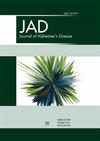为什么女性比男性更易患阿尔茨海默病:性别和淀粉样蛋白-肽的线粒体毒性。
IF 3.4
3区 医学
Q2 NEUROSCIENCES
引用次数: 370
摘要
患阿尔茨海默病(AD)的主要危险因素是年龄和性别。该疾病在女性中的发病率高于男性,这不能简单地归因于女性比男性寿命更长。因此,必须有一个特定的致病机制来解释阿尔茨海默病在女性中较高的发病率。在这方面,值得注意的是,与男性相比,年轻女性的线粒体免受淀粉样蛋白- β毒性的保护,产生较少的活性氧,释放较少的凋亡信号。然而,所有这些优势在老年女性的线粒体中都消失了。由于雌激素化合物可以防止淀粉样蛋白- β的线粒体毒性,雌激素的作用可能在保护细胞免受淀粉样蛋白- β毒性方面很重要,并提出了一种可能的治疗或预防AD的策略。不幸的是,到目前为止,银杏叶和其他雌激素疗法的临床试验尚未证明能成功治疗阿尔茨海默病。因此,确实需要更多的实验和临床试验来发现雌激素化合物可能对预防或治疗AD有用的条件。本文章由计算机程序翻译,如有差异,请以英文原文为准。
Why women have more Alzheimer's disease than men: gender and mitochondrial toxicity of amyloid-beta peptide.
The main risk factors for developing Alzheimer's disease (AD) are age and gender. The incidence of the disease is higher in women than in men, and this cannot simply be attributed to the higher longevity of women versus men. Thus, there must be a specific pathogenic mechanism to explain the higher incidence of AD cases in women. In this regard, it is notable that mitochondria from young females are protected against amyloid-beta toxicity, generate less reactive oxygen species, and release less apoptogenic signals than those from males. However, all this advantage is lost in mitochondria from old females. Since estrogenic compounds protect against mitochondrial toxicity of amyloid-beta, estrogenic action may be important in protecting cells from amyloid-beta toxicity and suggests a possible treatment or prevention strategy for AD. Unfortunately, to date, clinical trials with Ginkgo biloba and other estrogenic therapies have not proved successful in treating AD. As such, more experiments and clinical trials are indeed warranted to find conditions in which estrogenic compounds may be useful to prevent or treat AD.
求助全文
通过发布文献求助,成功后即可免费获取论文全文。
去求助
来源期刊

Journal of Alzheimer's Disease
医学-神经科学
CiteScore
6.40
自引率
7.50%
发文量
1327
审稿时长
2 months
期刊介绍:
The Journal of Alzheimer''s Disease (JAD) is an international multidisciplinary journal to facilitate progress in understanding the etiology, pathogenesis, epidemiology, genetics, behavior, treatment and psychology of Alzheimer''s disease. The journal publishes research reports, reviews, short communications, hypotheses, ethics reviews, book reviews, and letters-to-the-editor. The journal is dedicated to providing an open forum for original research that will expedite our fundamental understanding of Alzheimer''s disease.
 求助内容:
求助内容: 应助结果提醒方式:
应助结果提醒方式:


